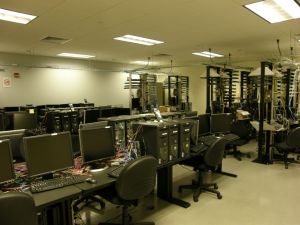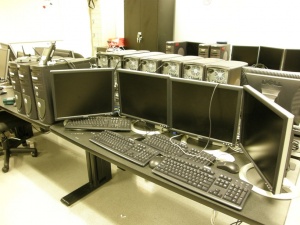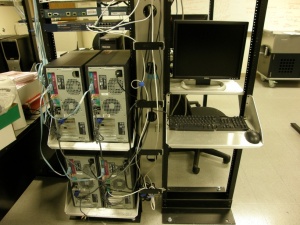Difference between revisions of "Teaching Labs/2027 EB2"
| (2 intermediate revisions by 2 users not shown) | |||
| Line 12: | Line 12: | ||
| − | {{# | + | {{#tag:iframe|key="local"|path="calendar/u/0/embed?src=ncsu.edu_6aofjsbgdfmigfbhmrqqe61nec@group.calendar.google.com&ctz=America/New_York"}} |
| − | | | ||
| − | |||
| − | |||
| − | |||
| − | |||
| − | |||
| − | |||
| − | }} | ||
Latest revision as of 11:06, 8 August 2022
Wireless Networking Lab
The Wireless Networking Lab supports both graduate and undergraduate studies in the fields of computer networking and network-based services. This lab contains one of the largest collections of computers and technology of any of our teaching labs, and is divided into two sections: the first provides a large number of Linux and Windows-installed computers for graduate courses and research, while the second provides "hubs" that consist of multiple computers, ethernet switches and routers and are used for projects and undergraduate courses.
Undergraduate courses in this lab introduce students to hardware, software, and concepts found within the networking field, while more advanced courses focus on wireless and cellular networks and technology. Additionally, the lab supports graduate research as well as undergraduate projects. In conjunction with other labs, the Wireless Networking lab supports the Master of Science degree in Computer Networking (MSCN) and its concentrations (e.g., SSME). As a joint effort between the College of Engineering and the College of Management, the program blends the technical and management aspects of computer networking in order to offer students a truly unique educational opportunity.
Lab Schedule
The schedule is subject to change at anytime, so check back often. To schedule this lab, email ecehelp@ncsu.edu.
Related Research Areas
Common Courses
Equipment
Undergraduate Network Hubs:
|
|
General use Linux computers:
|
Operating System:
| |||
Model:
|
Processor:
|
RAM:
|
General use Windows computers:
|
Operating System:
| |||
Model:
|
Processor:
|
RAM:
|
Additional Equipment:
|



